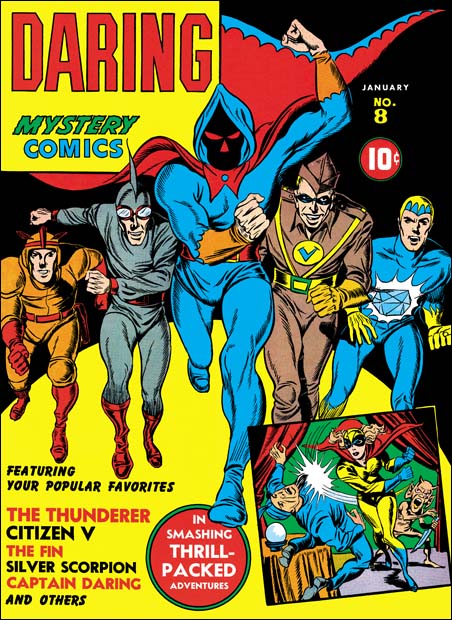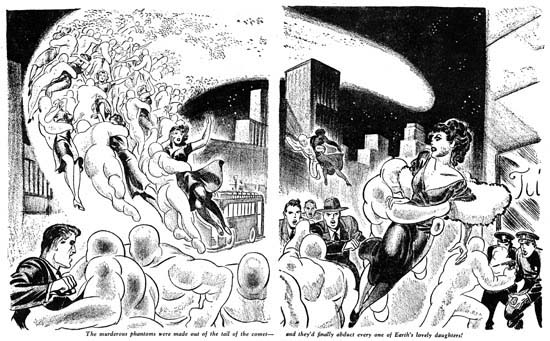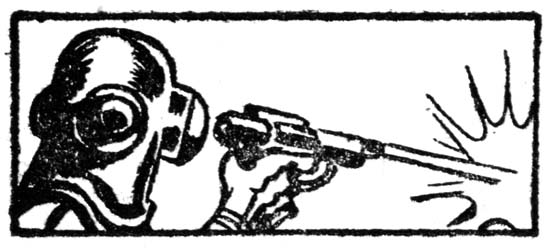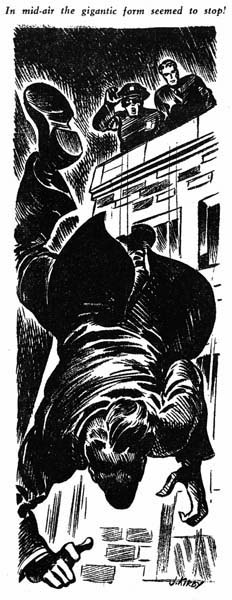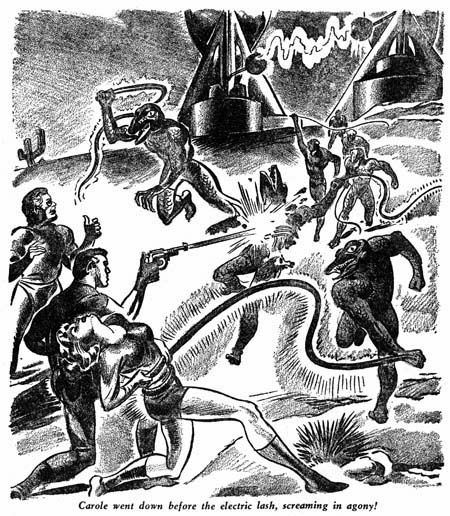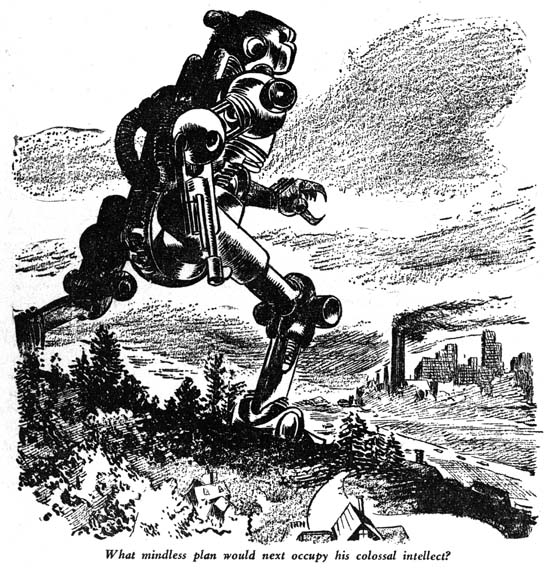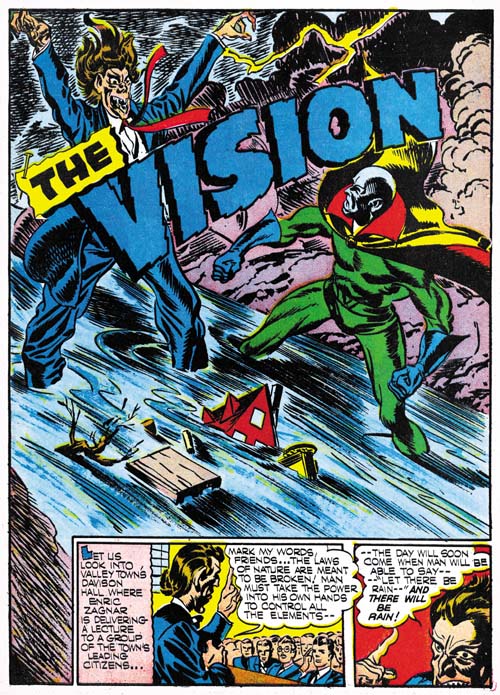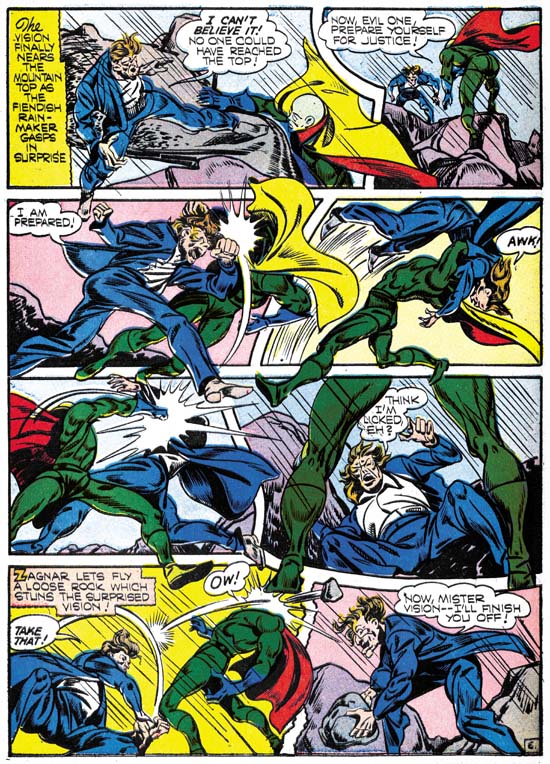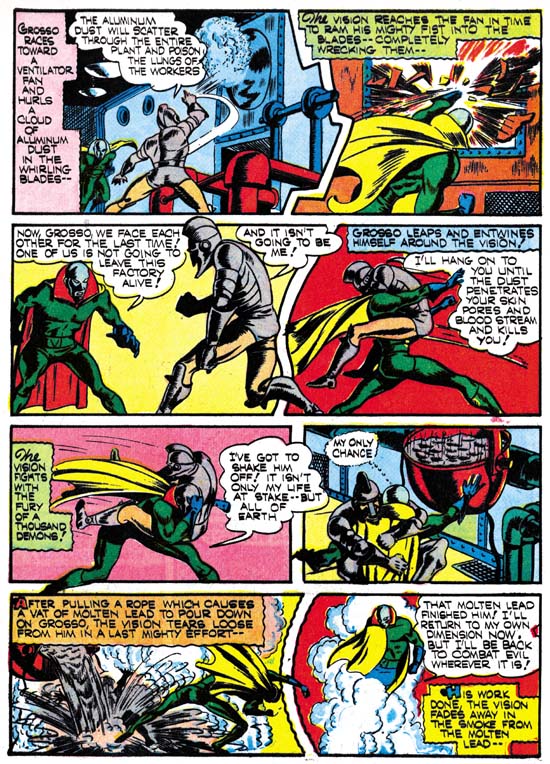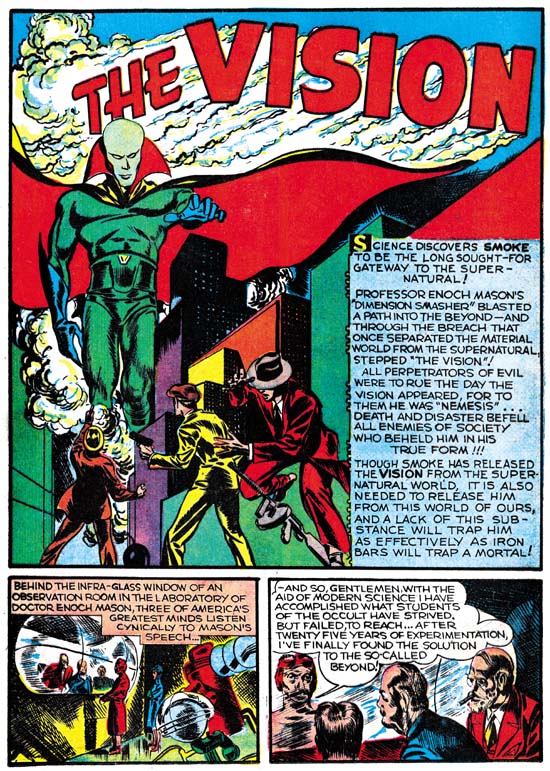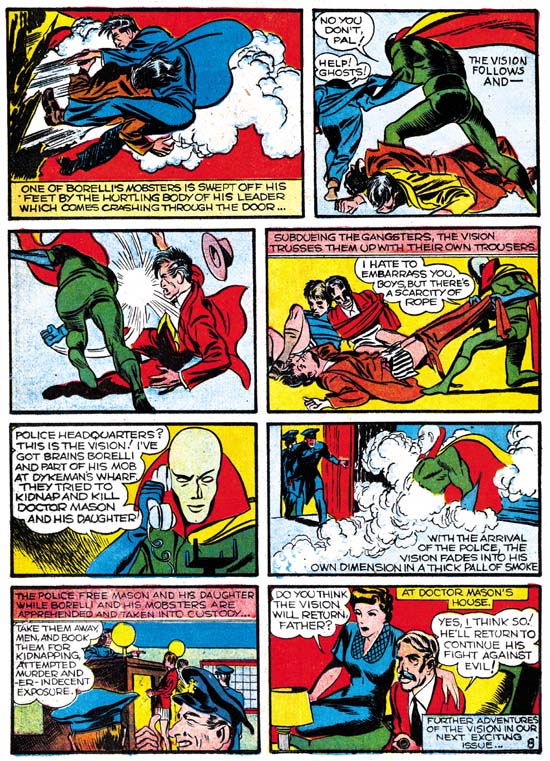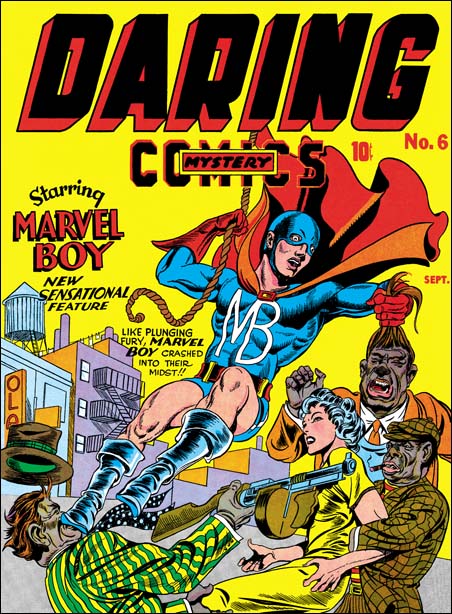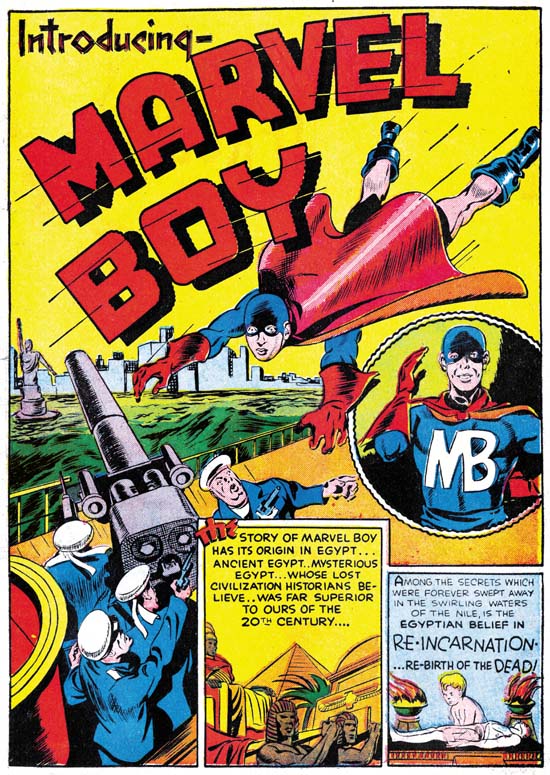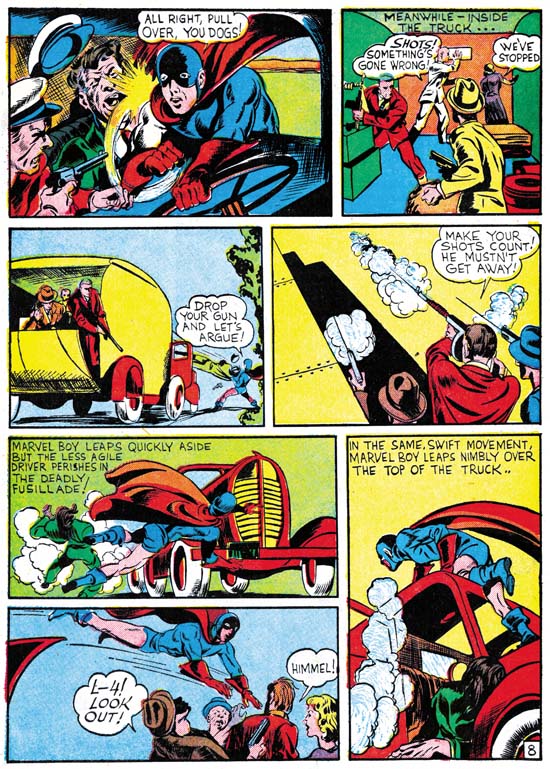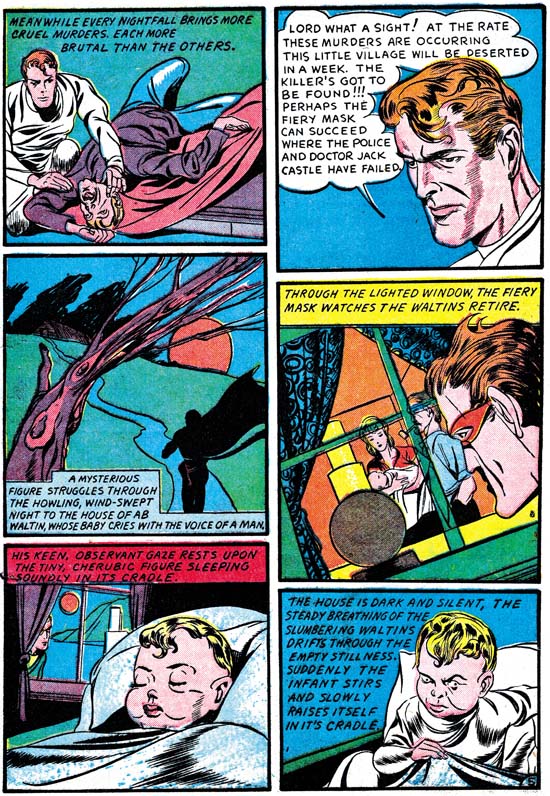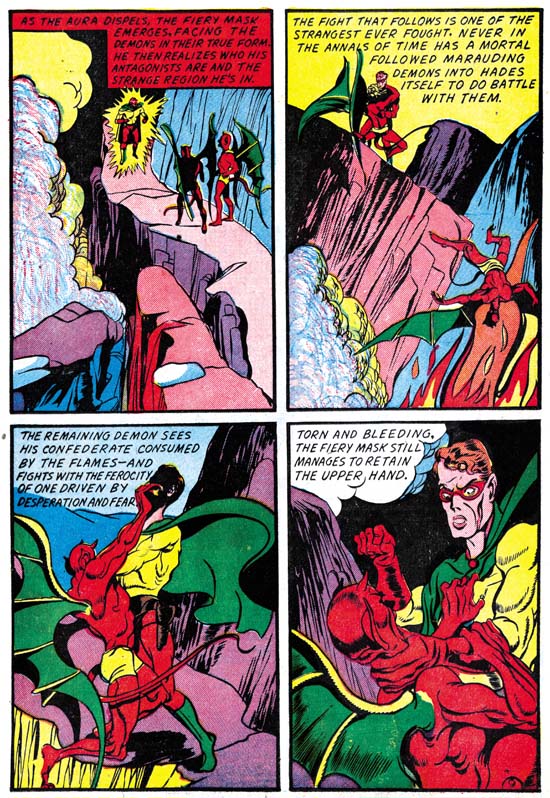It has been months since I wrote my last chapter to this serial post so I think I should remind the reader of where I left things off. Jack Kirby met Joe Simon while both were working for Fox Comics. After a few months Joe went on to be art editor for Timely and a short time later Jack followed. Joe’s first job was the launching of a new title, Red Raven Comics, which included work by Kirby. The publisher Goodman must of got a case of cold feet, because Red Raven was cancelled after the first issue, way too early to tell what the sales would be like. Jack would then do the art for a new backup feature for Marvel Mystery Comics called “The Vision”. The Vision would never achieve the prominence of the main Marvel Mystery features (the Human Torch, the Sub-Mariner or even the Angel) but Jack would end up drawing it for as long as he worked for Timely.
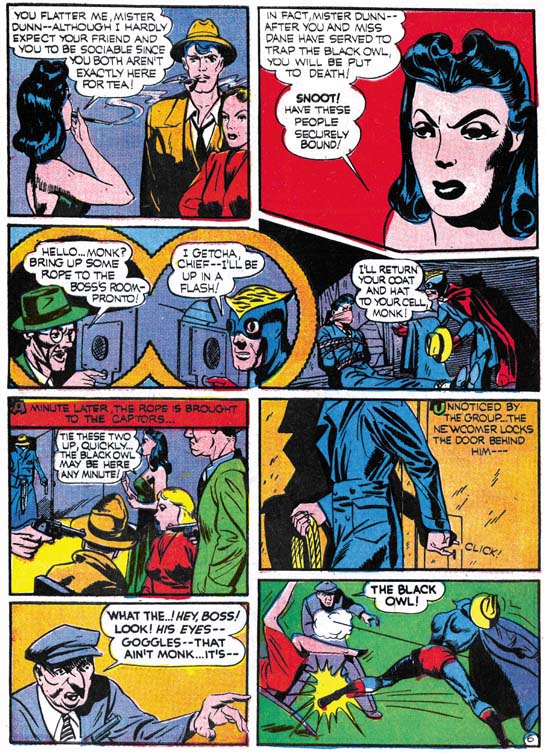
Prize Comics #9 (February 1941) “The Black Owl” page 6 art by Jack Kirby
Perhaps the most important work he was doing just before the launch of Captain America was the drawing for Blue Bolt. Simon and Kirby would now also do some freelance work for Prize Comics starting with a cover date of December 1940. The work for some already running features, the Black Owl and Ted O’Neil. It is not clear if this was truly a Simon and Kirby gig or just Kirby since the work is unsigned. However the stories read very much like what would be done for The Vision and Captain America so I am inclined to believed that Joe was involved also. All penciling was certainly done by Jack.
The Black Owl is one of those forgotten Golden Age superheroes. With good reasons as far as I am concerned. Obviously a take off on Batman, the creators failed to provide a decent costume. The suit and cape are completely nondescript. The only unique portion was the mask. But while Batman’s cowl might inspire fear in his foes, I cannot see the Black Owl’s mask getting more then a smirk. The Black Owl did have one feature that would have historical interest, his goggles. Similar goggles would reappear many years later in a Simon and Kirby creation that was never launched, the Night Fighter. Later yet Kirby would alter the Night Fighter to create the costume of the Fly (Archie Comics).
Despite the weak material they had to work with Simon and Kirby put together pretty good stories as for example in Prize Comics #9 (see image above). In an effort to thwart a mysterious woman gangster and her jewel robbing minions, a newspaper reporter concocts an article where the Black Owl promises to capture the mob. The article is read by a woman sleuth, the Black Owl himself in his secret identity and the female gang leader. That night while alone the reporter hears a noise. Now I have to admit that what follows is more then a little illogical. The reporter believes that the Black Owl is paying an expected visit, so the reporter turns off the lights and grabs the intruder. Only to find when he turns on the lights that he is holding the woman detective! Now if the reporter was really expecting the Black Owl, would he have tried to capture him? If, on the other hand, he wanted to be sure who the intruder was, would the reporter have turned off the lights? Illogical, but it does make for dramatic scene. They would handle this sort of thing a little better in the future, but it is just the twist that Simon and Kirby would often use later. Anyway the sleuth and the reporter wait it out together but instead of the Black Owl appearing, some of the jewel gang shows up to abduct the pair. It turns out that the Black Owl has observed it all and trails them. The kidnapped pair are brought to the lady crime master who plans to use them as bait to catch the Black Owl before being killed. Of course the Black Owl appears to save the day.
The Kirby art is a step up from what he did for Marvel Boy. You can see Jack beginning to put together elements of his classic style. Although reminiscent of what we will find in Captain America it still does not have quite the same punch. I am not sure about the inker, or possibly inkers. There are some parts that look like Joe Simon’s inking to me. For the most part panel layouts are irregularly sized panels that were typical of the work of both Joe and Jack at this point. However there are some uses of circular panels. One is a duel set (see image) showing a gang member speaking over an intercom to who he believes is another gangster but is actually the Black Owl. This pair of circular panels both shows the two sides of the conversation and also makes a visual suggestion to the Black Owl’s goggles. Another circular panel shows up on the next page, but that one is small and appears to have been added later since it both helps fill in the story while intruding on the existing panels. This use of circular panels is another harbinger of what will come when S&K produce Captain America.

Prize Comics #9 (February 1941) “Ted O’Neil” page 3 art by Jack Kirby
Ted O’Neil is an American pilot in the British Air Force. This is in the days before the U.S. had entered the war. While on leave with his sidekick Hinky, Ted finds himself in an air raid. Without enough time to enter a bomb shelter, the pair retreat to a nearby building. Once inside they hear a suspicious sound as if from a radio set. When they investigate they are knocked out and tied up. Their captors are German spies who are sending information of the position of British warships so that they can be attacked and destroyed. Before the spies can execute them, Ted and Hinky break free of their bonds and turn the tables to capture the spies. After delivering their prisoner to the authorities, Ted and Hinky fly off with their squadron to try to protect the British fleet. A fierce combat ensues which the English eventually win.
The spy angle would of course play an important part in the Captain America stories to come. As would the use of Nazi Germany as the enemy. No circular panels in the layouts, just the variously sized panels that often require arrows to indicate reading order. Kirby pencils throughout but again I am not sure if more then one inker was involved. Parts do suggest to me that Simon was inking at least some of it.
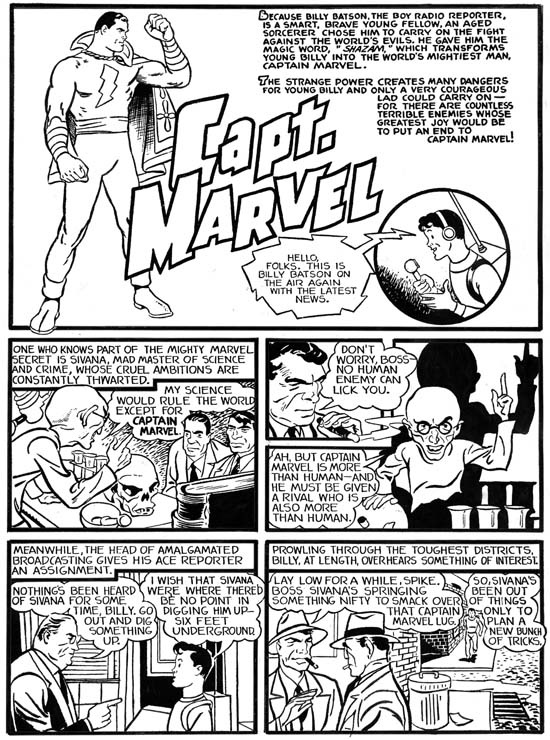
Captain Marvel, Special Edition (March 1941) bleached page art by Jack Kirby
Coming out the same month as Captain America was a special freelance job Simon and Kirby did for Fawcett’s Captain Marvel. Joe and Jack were effectively ghost artists and as such they are trying to mimic another artist’s style. Still you can easily detect their hand in this comic. Because they were ghosting it really is not fruitful to compare the work to other material they were doing. For this reason I am going to skip any analysis.
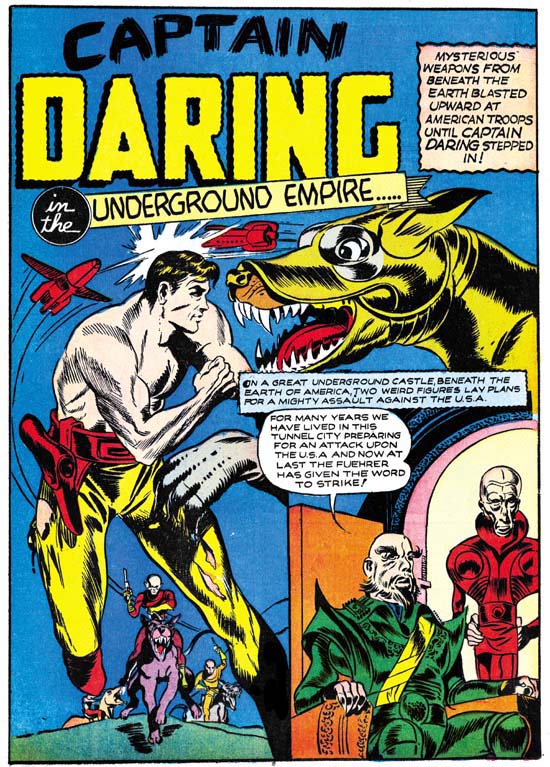
Daring Mystery #7 (April 1941) “The Underground Empire” page 1 art by Jack Kirby and unidentified artist
The next work by Kirby that I want to discuss is a Captain Daring story from Daring Mystery #7. This comic came out in April which is a month after the first issue of Captain America. But there are two reasons I feel it is appropriate to cover it here with the early Kirby work. One is that although this issue has a cover date of April, Daring Mystery #6 was dated September 1940. With such a long period between issues we cannot be certain about when the art was actually produced. The other reason is that Captain Daring is actually a science fiction story and very much related with other early work in this genre by Kirby.
I will give only the barest of outlines for this story. It concerns the attack on the modern day U.S.A. (that is modern for 1941) by a previously unsuspected underground empire. The enemy is resisted and eventually defeated by Captain Daring and Susan Parker, a beautiful female secret service agent. I do not provide more detail because I fear I am just not up to the task of condensing the story. It has so many jumps you almost get dizzy just from reading it. For instance we are introduced to Susan Parker as she is with Captain Daring watching over a futuristic telescope the destruction unleashed by the underground army. Later we suddenly find her with an army mounted on giant dogs that they liberated from some of the underground forces. She is leading a ground attach while Captain Daring fights above in sun powered rockets. At the end of the story she it is said that she was elected queen of the liberated underground masses. This sort of erratic turns occur throughout the story. It makes for a great read but only if you simply do not worry too much about the continuity of the plot.
There is something funny about the whole story. Although it purports to be taking place in America everything looks futuristic. There are a several fight scenes which the captions state are between Americans and the underground forces but the art depicts all the fighters as dressed in the same shorts and all look like the underground race. Actually the whole concept of an underground race is funny since nothing looks like it is taking place below the surface. I am convinced that this story was rewritten from a early version with minimal, if any, art changes. In fact it could of originally been meant for Solar Legion or Comet Pierce. All the references to the underground race, America and the Fuehrer were added later. Was this an early case of Kirby being rewritten by an editor (with Joe Simon taking the place of Stan Lee)? Or did Kirby do the rewriting himself? I cannot be sure but I would guess the latter, it all sounds like Kirby to me.
“The Underground Empire” is unsigned but in this case it looks like the work of Jack alone without much help from Joe Simon. All the penciling was done by Jack and I also attribute the inking to him. The art as well as the panel layouts are good matches for previous science fiction that Kirby had done. Even the inking style is the same. The only significant difference is the modern day references, which as I commented above I do not believe were part of the story when it was first made. But these alterations could be a reflection of Simon and Kirby’s work on Captain America.
I attributed all the art to Jack alone, but there is one exception. The figure of Captain Daring on the splash page (see image above) was neither penciled nor inked by Jack. I am not sure why this was done, most of the rest on the page surely was by Kirby except maybe the dogs in the background. Perhaps an original figure had something that was too clearly identified with its original source. But if that was the case why didn’t Kirby do the rework? I do not know who the artist was but it does not look like Joe Simon’s work either.
The launch of Captain America brought an end to Kirby’s early period. There was a sudden curtailing of freelance work outside of Timely. Perhaps Simon and Kirby realized that Captain America was likely to be a hit. Maybe producing Cap left little spare time for doing other work. Possibly the money they made at Timely plus the promise (unfulfilled) of royalties made the lower page rates of their freelancing unattractive. Whatever the reason S&K even stopped doing their previously most successful job, Blue Bolt. Joe and Jack did not give up freelancing entirely, however what outside work they they did would be limited to covers.
A big change came over Jack’s art as well. We caught premonitions of what was to come in Blue Bolt, Marvel Boy and the Black Owl. You could say the early work laid the foundations. In Captain America these hints blossomed into extraordinary pieces of comic book art. Irregular shaped panels including circular ones, figures extending beyond the panel boundaries, bodies in unusual posses stretched by the exertions of their action, fast pass stories, and so on. With all the comic history in between, it is hard for us to appreciate how startling Captain America was. There was nothing at all like it at the time. Other artists began copying what Jack and Joe were doing. The public eagerly bought up the comic and Captain America became a big hit. Simon and Kirby became a brand name. But that, as they say, is a story for another day.



